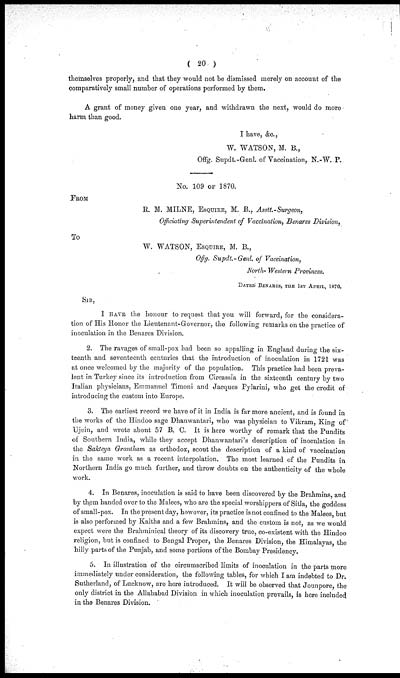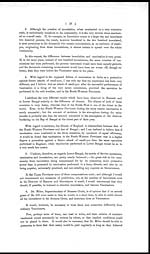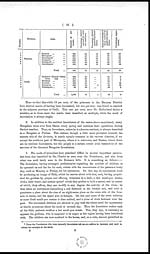Medicine - Vaccination > 1866-1901 - Annual report upon vaccination in the North-Western Provinces > Vaccination North-Western Provinces 1866-1877 > 1869-1870 - North-Western Provinces. Returns of vaccination for the season of 1869-70
(36) Page 20
Download files
Individual page:
Thumbnail gallery: Grid view | List view

( 20 )
themselves properly, and that they would not be dismissed merely on account of the
comparatively small number of operations performed by them.
A grant of money given one year, and withdrawn the next, would do more
harm than good.
I have, &.c.,
W. WATSON, M. B.,
Offg. Supdt.-Genl. of Vaccination, N.-W. P.
No. 109 OF 1870.
FROM
R. M. MILNE, ESQUIRE, M. B., Asstt.-Surgeon,
Officiating Superintendent of Vaccination, Benares Division,
To
W. WATSON, ESQUIRE, M. B.,
Offg. Supdt.-Genl. of Vaccination,
North- Western Provinces.
DATED BENARES, THE 1ST APRIL, 1870.
SIR,
I HAVE the honour to request that you will forward, for the considera-
tion of His Honor the Lieutenant-Governor, the following remarks on the practice of
inoculation in the Benares Division.
2. The ravages of small-pox had been so appalling in England during the six-
teenth and seventeenth centuries that the introduction of inoculation in 1721 was
at once welcomed by the majority of the population. This practice had been preva-
lent in Turkey since its introduction from Circassia in the sixteenth century by two
Italian physicians, Emmanuel Timoni and Jacques Pylarini, who get the credit of
introducing the custom into Europe.
3. The earliest record we have of it in India is far more ancient, and is found in
the works of the Hindoo sage Dhanwantari, who was physician to Vikram, King of
Ujein, and wrote about 57 B. C. It is here worthy of remark that the Pundits
of Southern India, while they accept Dhanwantari's description of inoculation in
the Sakteya Grantham as orthodox, scout the description of a kind of vaccination
in the same work as a recent interpolation. The most learned of the Pundits in
Northern India go much further, and throw doubts on the authenticity of the whole
work
4. In Benares, inoculation is said to have been discovered by the Brahmins, and
by them handed over to the Malees, who are the special worshippers of Sitla, the goddess
of small-pox. In the present day, however, its practice is not confined to the Malees, but
is also performed by Kaiths and a few Brahmins, and the custom is not, as we would
expect were the Brahminical theory of its discovery true, co-existent with the Hindoo
religion, but is confined to Bengal Proper, the Benares Division, the Himalayas, the
hilly parts of the Punjab, and some portions of the Bombay Presidency.
5. In illustration of the circumscribed limits of inoculation in the parts more
immediately under consideration, the following tables, for which I am indebted to Dr.
Sutherland, of Lucknow, are here introduced. It will be observed that Jounpore, the
only district in the Allahabad Division in which inoculation prevails, is here included
in the Benares Division.
Set display mode to: Large image | Zoom image | Transcription
Images and transcriptions on this page, including medium image downloads, may be used under the Creative Commons Attribution 4.0 International Licence unless otherwise stated. ![]()
| Permanent URL | https://digital.nls.uk/87224187 |
|---|
| Attribution and copyright: |
|
|---|




